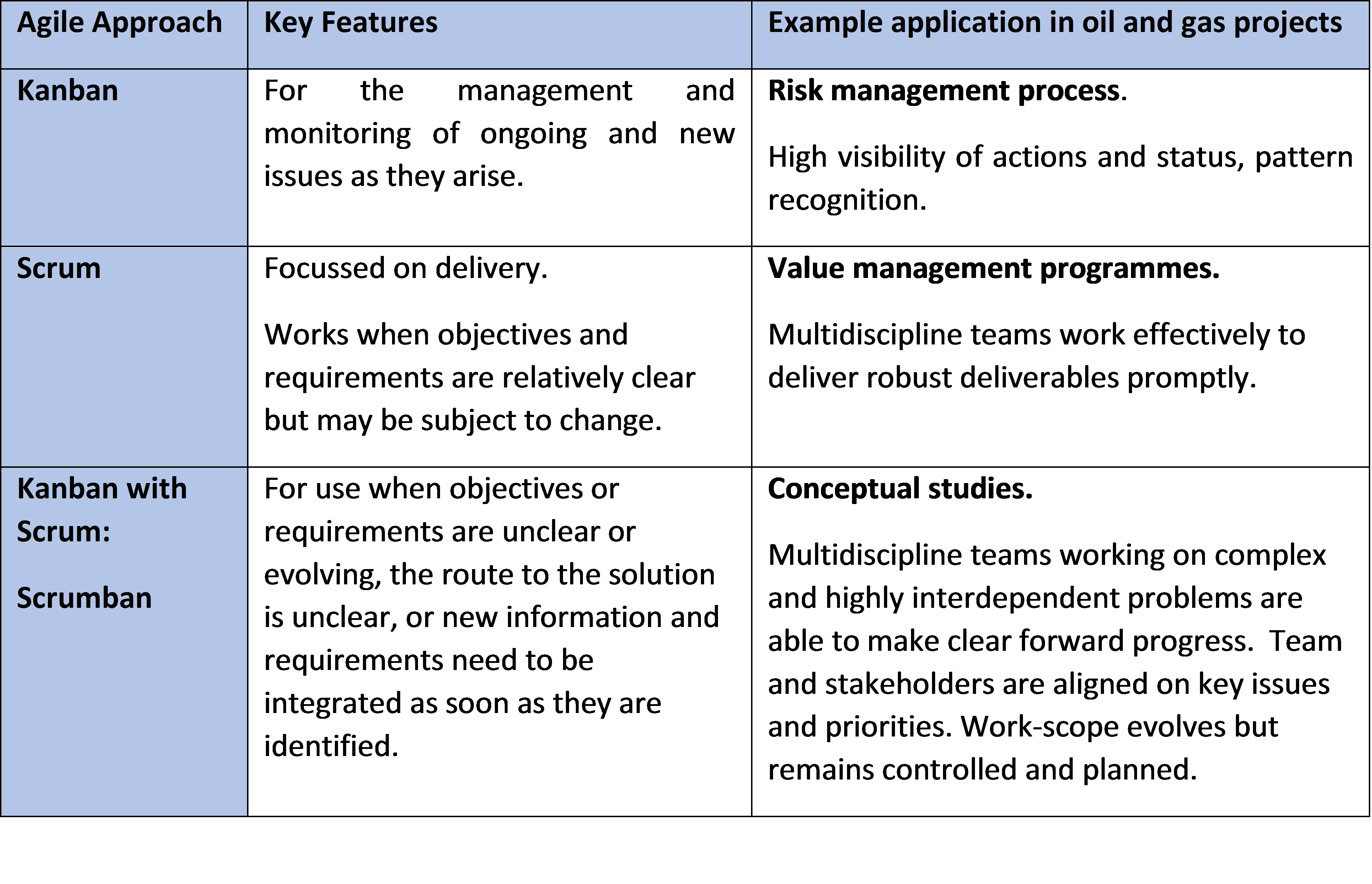Being more agile in oil & gas projects
Project Management Risk Management Value ManagementTraditional defined project control mechanisms require project scope to be broken down into well understood, discrete, interdependent tasks. This is ideal for activities where there is a clear picture of the final outcome and where there is low likelihood, requirement, or desire to accommodate change. Such approaches are well suited to the later detailed engineering, procurement and construction phases of projects where efficiency of production (whether producing detailed engineering drawings or cutting steel) becomes the defining measure of success.
Agile methods, on the other hand, offer an empirical control model that works through frequent inspection and adaptation.
What is agile?
Agile practices originated in the software industry in the 1990s as a reaction against traditional documentation driven, heavyweight software development processes. They are applied to bring order to projects where teams are working in loosely defined steps towards solutions as yet unclear.
Agile is not a specific methodology or workflow, but a set of values that define the way projects are approached. Agile is an umbrella term for a range of “lightweight” development frameworks that place emphasis on:
- The individuals delivering the work and their interactions
- Incremental delivery of solutions and decisions
- Collaboration with customers and stakeholders
- Responding to change
Applying agile to oil and gas projects
Here are three popular agile approaches that Agilis believe offer value to the oil and gas industry:
Kanban
Kanban (Japanese for signboard or billboard) is a scheduling system used for lean and just-in-time (JIT) production. It creates a visual workflow for items awaiting action, in progress, and completed. As such it can be used to track progress of longstanding items through a process and allows status, progress, priority information, and areas requiring attention to be easily shared among project participants and stakeholders.
Web-based Kanban tools can be particularly valuable for distributed teams working across a number of different time zones.
Scrum
Scrum is a tool used to organise work into small, manageable pieces that can be completed by a cross-functional team within a prescribed time period. Work is done in a series of fixed length iterations or “sprints”.
Definition and prioritisation of work
Work is broken down into a single list of requirements, prioritised against business objectives.
New items can be added to the list at any time but will not be addressed until the start of the next sprint.
Sprints
Each sprint is kicked off with a sprint planning meeting at which sprint goals are agreed with all stakeholders by selecting work items from the prioritised requirements list.
The multi-discipline scrum team hold short (less than 15 minutes), regular (often daily) meetings (by VC or in person) to share progress towards the sprint goals.
Each sprint is concluded with a sprint review meeting where the completed work is presented to stakeholders and any adjustments to the requirements list made. An internal sprint retrospective meeting then allows the team to reflect on how the sprint went and identify any learnings or areas for improvement.
Completion
The cycle repeats until enough of the work is completed, the budget is depleted, or the deadline arrives.
Scrum ensures the efficient completion of work in order of its value to an organisation within a fixed timescale or budget.
Scrum with Kanban (“Scrumban”)
Scrumban is a hybrid methodology where teams use scrum as their way of working combined with the freedom offered by Kanban to pull new items into a sprint and change in-sprint priorities.
What next?
Agile practices have been adopted across a variety of industries and are now viewed as mainstream by organisations such as PWC and PMI. According to PWC’s 2014 bi-annual global Portfolio and Programme Management Survey organisations need to embrace flexibility and adaptability in order to compete and survive.
At its simplest, agile project delivery is about bringing an agile mindset to delivering organisational or project objectives. We have outlined Scrum and Kanban as two of the most popular agile approaches, but implementation of agile can be as diverse or limited as the imagination of the project management team allows. Blogger Abby Fichtner, writing about how to “be agile”, points out that projects should make use of the agile management and technical practices that best suit their needs and objectives.
So implementation of agile in an organisation may range from a “light touch” approach where small changes are made to improve effectiveness of existing management systems, to a disruptive innovation intended to turn conventional project execution on its head.
According the PMI’s Pulse of the Profession 2015 report, agile organisations have significantly better project outcomes compared to their low agility counterparts. In the 2015 State of Scrum Report a diverse range of respondents overwhelmingly agreed that agile projects are improving the quality of work life for their teams.
Time for a change?

